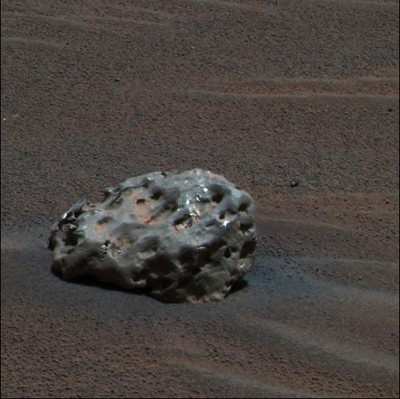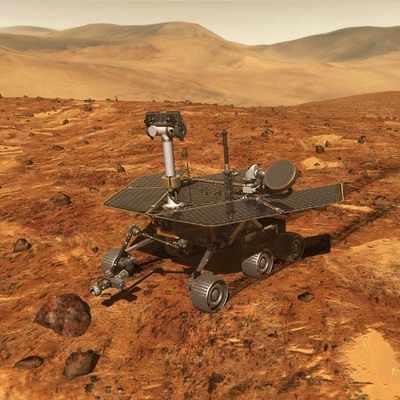Opportunity Scores Again; Scientists Very Pleased
If you go exploring the neighborhood, you never know what you'll
find. Especially if you're NASA's incredible, overachieving Mars
rovers, Spirit and Opportunity. This week Opportunity, cruising the
Meridiani Plain, poked around looking at,and photographing, one of
the heat shields that it jettisoned on descent to the planet. Then
it moved on to a basketball-sized rock that rover program
scientists had been calling "Heat Shield Rock" for its proximity to
the discarded shield. The conclusion: the rock was a meteorite,
fallen from space, and made mostly of an alloy of iron and
nickel.

Now, this is not as big as the historic discovery that Mars once
ran with liquid water, which was also made by Opportunity on the
Meridiani (and confirmed by Spirit on the other side of the Red
Planet). But it is very significant science nonetheless. It's the
first identified, confirmed meteorite on any planet but Earth.
"This is a huge surprise, though maybe it shouldn't have been,"
said Dr. Steve Squyres of Cornell University, who is the lead
scientist for the experimental instruments the rovers carry.
"I never thought we would get to use our instruments on a rock
from someplace other than Mars," Squyres added. He explained that
the meteorite came from "a destroyed planet or planetesimal that
was big enough to differentiate into a metallic core and a rocky
mantle." (We're not principal science investigators on NASA
projects, so "planetesimal" was a new word to us, also. It refers
to small celestial bodies that are believed to have existed in
large quantities during the formation of the solar system).
Aren't there plenty of meteorites on Earth to study? Squyres
explains that it's not what we can learn about meteorites, but what
we can learn about the Meridiani and about Mars. Planetary
scientists would like to know whether the surface is being eroded,
or being built up. The numbers and condition of meteorites on the
planet's surface maybe the clue needed to answer this question.

NASA Chief Scientist Jim Garvin suggests another benefit from
the meteorite discovery: it "opens new research possibilities,
including further incentives for robotic and then human-based
sample-return missions."
The Mars Exploration Rover project began in 2000, and has
exceeded all expectations. The Rovers have proven to be
unexpectedly durable. They were only supposed to last 90 days -- in
which case they'd have gone silent after April, 2004. Opportunity
has survived 352 "sols," or Martian days, and Spirit, which landed
first in the Gusev crater on the other side of the planet, has
survived 372. They have traveled a total of more than 3.8 miles,
have sent back 66,000 pictures, and have taken countless
spectrographic measurements. The rovers have been up and running
for over four times their expected duration, and have covered over
five times their initially planned distance.
A very satisfied Jim Garvin summed it up: "Mars continues to
provide unexpected science 'gold,' and our rovers have proven the
value of mobile exploration with this latest finding."
 Klyde Morris (05.02.25)
Klyde Morris (05.02.25) Classic Aero-TV: Introducing The MD302--Mid-Continent's Standby Attitude Module
Classic Aero-TV: Introducing The MD302--Mid-Continent's Standby Attitude Module ANN's Daily Aero-Linx (05.04.25)
ANN's Daily Aero-Linx (05.04.25) ANN's Daily Aero-Term (05.04.25): Jamming
ANN's Daily Aero-Term (05.04.25): Jamming Aero-News: Quote of the Day (05.04.25)
Aero-News: Quote of the Day (05.04.25)




